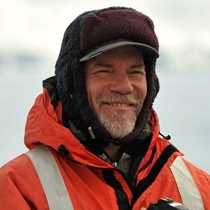Loen, Nordfjorden
Gadus morhua, the fish of empire, a strong contender for the title of most geopolitically significant marine species in history, the Atlantic cod. Its firm white flesh, easily dried and preserved, brought the Basques to the Grand Banks off Newfoundland long before Columbus sailed. Dried cod and salt cod, delicacies in many nations and a practical necessity in Catholic Europe, built the great Hanseatic League that dominated north European trade for several centuries. Bacalao, cod liver oil, fish and chips – this fish has permeated western culture in ways that very few other species of the land or sea can rival.
Today, the great cod of the Grand Banks are gone, fished to near extinction. But, in the seas off Norway and Iceland, isolation and careful management have preserved some healthy stocks and we have seen them throughout our journey south from the high Arctic to Norway. In the Lofoten islands we were surrounded by traditional racks of dried cod, a sight unchanged for many centuries. Thanks to the efforts of our crew, fresh caught cod appeared several times on the National Geographic Endeavour’s dinner menu. Tomorrow we will complete our voyage in Bergen, Norway’s second largest city, a great center of the Hanseatic League, which grew to prosperity through the trade in cod.
And, diving in the deep waters of the fjords, there they were. Even today, when the 80-pound giants of the past are mostly long gone, Atlantic Cod are impressive fish, often close to three feet long and over 30 pounds. Long distance migrants, dominant predators, they rather look their part as well, gazing at visiting divers with a kind of venerable fishy wisdom before turning and swimming away, vanishing into the dark waters of history.
Gadus morhua, the fish of empire, a strong contender for the title of most geopolitically significant marine species in history, the Atlantic cod. Its firm white flesh, easily dried and preserved, brought the Basques to the Grand Banks off Newfoundland long before Columbus sailed. Dried cod and salt cod, delicacies in many nations and a practical necessity in Catholic Europe, built the great Hanseatic League that dominated north European trade for several centuries. Bacalao, cod liver oil, fish and chips – this fish has permeated western culture in ways that very few other species of the land or sea can rival.
Today, the great cod of the Grand Banks are gone, fished to near extinction. But, in the seas off Norway and Iceland, isolation and careful management have preserved some healthy stocks and we have seen them throughout our journey south from the high Arctic to Norway. In the Lofoten islands we were surrounded by traditional racks of dried cod, a sight unchanged for many centuries. Thanks to the efforts of our crew, fresh caught cod appeared several times on the National Geographic Endeavour’s dinner menu. Tomorrow we will complete our voyage in Bergen, Norway’s second largest city, a great center of the Hanseatic League, which grew to prosperity through the trade in cod.
And, diving in the deep waters of the fjords, there they were. Even today, when the 80-pound giants of the past are mostly long gone, Atlantic Cod are impressive fish, often close to three feet long and over 30 pounds. Long distance migrants, dominant predators, they rather look their part as well, gazing at visiting divers with a kind of venerable fishy wisdom before turning and swimming away, vanishing into the dark waters of history.




